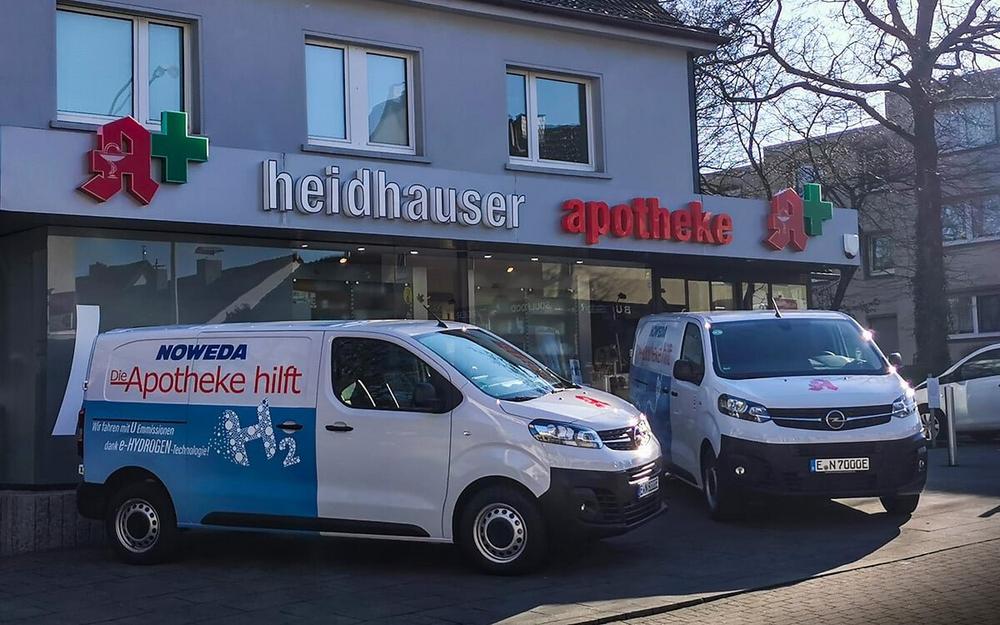Refrigerated Pharmacy Deliveries with Opel Vivaro-e and Vivaro-e HYDROGEN

Kathmandu Nepal
Mittwoch, Jan. 8, 2025

The Opel Vivaro-e and the Opel Vivaro-e HYDROGEN were recently added to the fleet of the NOWEDA pharmacy cooperative in Essen, Germany. More precisely: The battery-electric and hydrogen fuel cell vans are currently proving their suitability for everyday use for the pharmaceutical wholesale company when delivering sensitive products such as medicines and showing that they meet the requirements of the EU’s Good Distribution Practice (GDP). According to this, medicines must be transported in a vehicle whose loading space is climatised between 15 and 25 degrees Celsius in accordance with standard 2013/C 343/01 GDP in order to continuously ensure the quality of medicines.
Joachim Glass, Key Account Manager for Opel commercial vehicle conversions and special solutions, said: “NOWEDA is a major customer and has many Opel vehicles in its fleet. NOWEDA has shown a keen interest in vehicles with alternative drives for many years. The pharmacists‘ cooperative sees hydrogen and fuel cell technology as a promising opportunity to make their vehicle fleet more sustainable and ecological. It is our job to be able to offer suitable solutions with our vans and the right, tried and tested partners.”
In order to be able to cope with the daily tasks, vehicles are required that, like the Opel Vivaro-e, can drive up to 328 kilometres, and the innovative Vivaro-e HYDROGEN that can cover up to 400 kilometres according to WLTP with no local emissions between charging or refuelling stops. On the other hand, they need to meet the complex demands placed on sensitive goods, especially in the loading area. This is where the certified conversion specialists Fahrzeugbau Dülmer GmbH and CSA ClimaVan Solutions Automotive GmbH come into play.
Vivaro-e HYDROGEN: CSA conversion with air heating, weight-saving partial insulation
For the Opel Vivaro-e HYDROGEN, CSA ClimaVan Solutions Automotive GmbH has taken over the conversion for the transport of medicines. To do this, the specialists first installed a self-developed cooling and heating unit under the load compartment ceiling near the driver’s cabin; the supply hoses and cables are mostly protected by panels. According to the GDP standard, the refrigerant compressor for cooling and heating operation must not be driven by the vehicle electric motor in battery-electric or hydrogen-powered vehicles, but must be fed by separate batteries that can be charged from the outside. This has also been implemented. The CSA solution is heated with air.
The controller and the separate battery are located in the enlarged wheel arches of the converted Vivaro-e HYDROGEN. The control unit for temperature regulation in the cargo hold is located on the left side of the dashboard. In addition, the compressor, condenser and dryer are all placed in the spare wheel well. In order to save weight and to maintain the full loading volume, CSA has not covered the partition at the rear of the driver’s cab. In the cargo area itself, non-slip materials ensure that goods are transported safely.
Vivaro-e: Dülmer relies on all-round insulation and water heating
This also applies to the Opel Vivaro-e converted by Fahrzeugbau Dülmer GmbH. Here, too, anti-slip materials and high-strength lightweight construction methods are used in the load compartment. In contrast to CSA, Dülmer relies on all-round insulation of the side walls and partition for the solution tested in the company’s own climate chamber. This is intended both to maintain the desired load compartment temperature for longer and, thanks to smooth wall surfaces, to make it easier to transport stackable medicine tubs.
In the battery-electric Vivaro-e, the cooling and heating unit – here from Webasto – is also mounted to the ceiling of the load compartment with the compressor, condenser and dryer located in the spare wheel well. Elsewhere the water heater is under the floor. With the Dülmer solution, the separate battery and the control are housed in a box behind the driver’s seat in the cargo area. The load compartment temperature can be regulated via a unit in the centre stack.
Locally emission-free use: apparent from first sight
From the outside, the two Opel vans used by NOWEDA make it clear that they are locally emission-free and therefore resource-saving. The battery-electric Vivaro-e shows an oversized power cable on the sides with the note “100% fully electric delivery thanks to the e-drive!”; and the hydrogen fuel cell transporter states: “We drive with 0 emissions thanks to e-HYDROGEN technology!”. In addition, it signals its sustainability with a stylised H2 print depicting air bubbles.
The specialists estimate around four weeks after delivery of the base vehicle for the respective conversions. Interested parties can get advice on this from their Opel partner.
Opel Automobile GmbH
Bahnhofsplatz
65423 Rüsselsheim
Telefon: +49 (6142) 7-70
Telefax: +49 (6142) 77-8409
http://de-media.opel.com/de
![]()